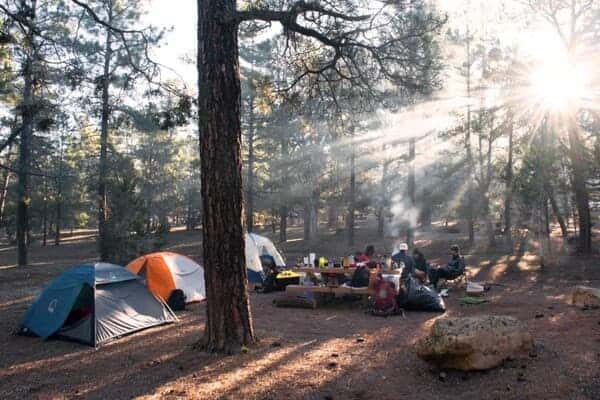Educational outdoor activities provide children with a unique way to play and learn. Moving the classroom outside allows learners to experience a balance between education and the natural world. It’s not just about having fun, although that’s a big part of it; it’s also about applying curricular concepts in a practical and hands-on environment.
Key Takeaways:
- Outdoor learning activities offer a hands-on approach to education, enhancing children’s engagement and understanding.
- These activities contribute to a well-rounded experience, promoting creativity, physical activity, and real-world application of knowledge.
- Community and parental involvement are key to enriching the outdoor educational experience and supporting children’s development.
Types of Educational Outdoor Activities
Educational outdoor activities provide children with unique opportunities to engage with their environment, build physical fitness, and foster creative expression. These activities can enhance a child’s learning through direct interaction with nature and the outdoors.
Science and Nature Exploration
One can find kids deeply immersed in science and nature exploration activities, often involving hands-on learning. They may examine plant species, document wildlife behavior, or conduct simple outdoor experiments that reveal the principles of ecology. For example, leaf identification guides help them to match shapes with tree species.
Amber Crow Pro-Tip: Create a nature journal for kids to record their observations. Encourage them to draw what they see, write down questions, and research the answers later. This enhances observation skills and scientific inquiry.
Outdoor Physical Activities
Outdoor physical activities for kids often combine learning with movement. Relay races can incorporate math skills by requiring calculations for each leg of the race. Additionally, obstacle courses can teach children about the physics of motion and the importance of physical activity for health.
Creative Arts and Craft
Arts and crafts inspired by nature allow children to use materials found outdoors to create artwork. For instance, they might construct a mosaic from leaves, twigs, and pebbles, reinforcing their understanding of nature’s textures, patterns, and colors.
Literacy and Storytelling
Storytelling and literacy activities outside engage children’s imaginations and build language skills. They could be tasked with writing a story inspired by their surroundings or participate in a forest-themed scavenger hunt that prompts vocabulary development and comprehension while traversing the great outdoors.
| Type of Activity | Educational Benefit | Example Activities |
|---|---|---|
| Science and Nature Exploration | Enhances observation skills and scientific inquiry | Plant species examination, wildlife documentation, outdoor experiments |
| Outdoor Physical Activities | Combines learning with physical movement, teaching about physics and health | Relay races with math calculations, obstacle courses |
| Creative Arts and Craft | Fosters creativity and appreciation for nature’s textures, patterns, and colors | Nature mosaics from leaves, twigs, and pebbles |
| Literacy and Storytelling | Builds language skills and imagination | Writing stories inspired by surroundings, vocabulary development through scavenger hunts |
| STEAM and STEM Approaches | Applies classroom concepts in practical, hands-on environmental projects | Planting a school garden, constructing simple machines |
| Math and Measurements | Makes math tangible and relevant through practical application | Tree height measurement with trigonometry, area calculations of schoolyard plots |
| Social Studies in the Fresh Air | Brings geography and history to life | Mapping local area history, simulating archaeological digs |
Integrating Curriculum with Outdoor Learning

Outdoor learning is an immersive platform where students can deepen their understanding of various subjects, from science to social studies. Teachers can craft impactful STEAM and STEM activities that utilize the natural world to reinforce classroom learning.
STEAM and STEM Approaches
Educators can engage students with hands-on environmental projects by incorporating STEAM and STEM activities outdoors. For example, they might study plant biology by planting a school garden or explore physics by constructing simple machines from natural materials. This integration enriches learning by allowing students to apply concepts in a tangible setting.
Amber Crow Pro-Tip: Encourage project-based learning where children can build models or conduct experiments based on outdoor observations. For example, building a simple water filtration system or a model of an ecosystem.
Natural Science Subjects
Outdoor science becomes vivid when students step outside to experience ecosystems firsthand. Elementary science curricula come alive as students observe local wildlife, weather patterns, and plant life. Such direct exposure helps students to retain material and foster a deeper interest in scientific inquiry.
Math and Measurements
Math lessons can transcend textbooks with outdoor activities focused on measurements. Finding the height of trees using trigonometry or calculating the area of schoolyard plots brings an abstract subject into the real world, bolstering comprehension and making math tangible and relevant.
Social Studies in the Fresh Air
Regarding social studies, the outdoors can be a canvas for exploring geography and history. Students might map the history of their local area or simulate archaeological digs. This method helps create a vivid connection to the past and the spaces they inhabit, making studying history and geography more engaging.
Guidelines for Safety and Focus
Ensuring the safety and focus of participants during outdoor educational activities is crucial. Educators must encourage consistent attentiveness and adhere to established safety protocols to create a conducive learning environment.
Maintaining Attention During Activities
- Strategies:
- Use engaging content: Incorporate interactive tasks that align with students’ interests to sustain their focus.
- Frequent breaks: Strategically timed breaks can help prevent fatigue and maintain patience.
- Observation Techniques:
- Active participation: Encourage students to ask questions and make observations to stay involved.
- Buddy system: Pair students to promote focused teamwork and peer accountability.
Ensuring Safety Outdoors
- Preparation:
- Weather-aware clothing: Advise the wearing of appropriate gear for existing weather conditions.
- Emergency protocols: Familiarize participants with procedures in case of an unexpected incident.
- Safety Practices:
- Supervision: Ensure adults are present to oversee activities and offer immediate assistance if needed.
- Environment checks: Regularly inspect the outdoor area for potential hazards.
Incorporating these approaches helps maintain safety and focus during educational outdoor activities.
Innovative Outdoor Classroom Ideas
Engaging students outside the traditional classroom walls can be highly effective, especially when innovative methods are employed. These ideas help educators bring learning to life in the great outdoors, leveraging technology, hands-on experiments, and real-world data collection.
Using Technology for Outdoor Learning
Integrating technology into outdoor education broadens the horizons for creative learning. Educators can guide students as they use mobile devices or tablets to follow an ebook that complements the day’s lesson. Similarly, blogs focusing on nature can provide supplementary material and outdoor classroom ideas. This blend of natural and digital learning environments can stimulate students’ interest and engagement.
Hands-on Science Experiments
The outdoors is a natural laboratory, ripe for exploration. Simple and effective science activities like building a DIY solar oven can teach students about renewable energy and sustainability. By using everyday materials to construct and test their solar ovens, students can learn concepts of physics and engineering firsthand.
Environmental Data Collection
Data collection is a fundamental part of the scientific method. Students can collect and analyze environmental data by employing compasses and other tools, gaining deep insights into ecological patterns and natural phenomena. They can study weather changes, learn to track wildlife or measure plant growth over time, making the experience both educational and memorable.
Engaging Parents and Community

Creating connections between educational outdoor activities and the broader community enriches the experience for kids. Parents play a crucial role in fostering a love for outdoor play and science, while community-driven projects provide a platform for collaborative learning and engagement.
At-Home Outdoor Activities
Parents seeking to engage their children in outdoor learning can start right at home. Activities such as backyard bird watching introduce kids to local wildlife, while cultivating an interest in biology and environmental science. They can also set up a weather station where children track patterns and learn meteorological basics. For instance, monitoring rainfall or charting temperature changes makes for a hands-on science lesson.
- Backyard Scavenger Hunts: Tailoring the hunt to focus on native plants or insects can spark an interest in botany and entomology.
- Gardening Projects: Hands-on learning about plant life cycles, soil science, and the importance of pollinators.
Community-Driven Projects
Community-driven projects not only bolster educational opportunities but also strengthen communal bonds. Parents can work with local schools or environmental organizations to create events such as a Community Garden Day, where kids contribute to a public garden and learn about plant biology and the ecosystem.
- Stream or Park Clean-Ups: Children learn about pollution and conservation while giving back to their community.
- Nature Walks with Local Experts: These can be organized to educate families about the local flora and fauna, geology, and more.
Community and parental involvement in outdoor activities can significantly enhance children’s learning opportunities and foster a sense of responsibility towards their environment.
Amber Crow Pro-Tip: Host a ‘family nature day’ where students and their families participate in guided outdoor activities. This encourages community bonding and extends learning beyond the classroom.
Frequently Asked Questions
Outdoor educational activities offer a dynamic way to engage learners of all ages. They promote physical health, mental well-being, and a deeper environmental connection. Here are some common inquiries about integrating the outdoors into learning experiences.
What are some fun nature-based activities for engaging kids outdoors?
Kids thrive with hands-on exploration, and activities like scavenger hunts, nature walks, and building insect hotels encourage interaction with the natural world. They allow children to discover ecosystems while fostering a sense of wonder and adventure.
Can you list some outdoor learning games suitable for middle schoolers?
Middle schoolers benefit from games that challenge their problem-solving skills and creativity, such as geocaching, orienteering, and environmental science simulations. These games transform the outdoors into a living classroom where students can apply academic concepts in a meaningful context.
How do schools incorporate recreational activities into their curriculum?
Schools can integrate recreational activities by scheduling regular outside classes and fostering a culture that values active, experiential learning. Programs such as outdoor learning initiatives often include activities that align with educational standards while promoting engagement and enjoyment.
What types of outdoor activities are most beneficial for preschooler development?
Preschoolers develop essential motor skills and social competencies through play-based activities. Sand and water play, sensory gardens, and simple exploration of outdoor spaces can be especially beneficial for their growth and development.
How can high school students benefit from educational activities in an outdoor setting?
For high school students, outdoor adventures like field research projects, sustainability initiatives, and physical fitness challenges can supplement classroom learning. These activities help students develop real-world skills, leadership qualities, and personal responsibility.
What outdoor educational programs are suitable for adult learners?
Adults can engage with nature through programs like Master Gardener courses, wilderness survival workshops, and environmental advocacy training. Programs like these allow participants to pursue continuous learning and contribute meaningfully to their communities.
